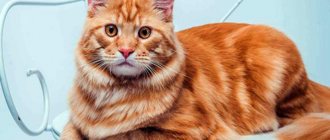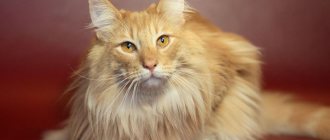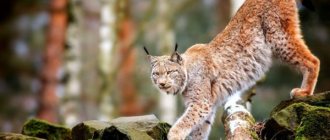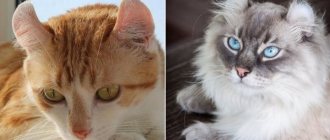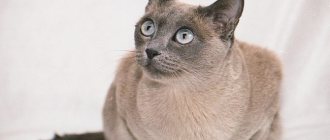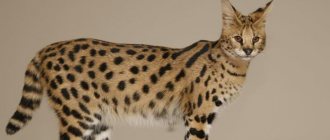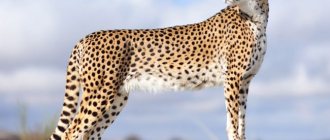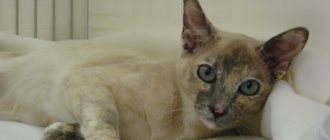The Siamese, who came from ancient Thailand, won the hearts of people back in the 16th century and received the nickname “moon diamond” from them. Siamese cats were introduced to Europe in 1884. Their intelligence, free spirit and loyalty have made them revered and beloved pets.
It turns out that cats similar to Siamese are found in nature very often. Thanks to breeding work, the Siamese today have a great many descendants. They all differ from each other both in appearance and in character.
Balinese
This cat breed got its name thanks to the plasticity and grace that cats have, named after the Balinese temple dancers.
This is a miniature, slender cat with unique grace. She is fluffier than the Siamese, she has an elongated body and long legs. The average cat weighs up to 4 kilograms.
Representatives of this breed are less aggressive than Siamese, friendly, sociable and very attached to their owner.
External features of cats
When crossing representatives of different breeds, there is a risk that the offspring will not inherit any desired characteristics. There is a general description of the external parameters of mestizos.
A mixed breed of Maine Coon and Siberian cat resembles a purebred cat in appearance. The colors and shape of the skull are similar. There are almost no external signs of Siberian admixture. At the same time, such mixtures do not grow to large sizes. In addition, such individuals do not have tufts on their ears.
Mixed Maine Coon and Siberian cat
Mixing a Maine Coon with a barn cat leads to the appearance of kittens that resemble a purebred animal in color and strong bones. At the same time, they are distinguished by a less flexible character. In addition, not all the positive qualities of a purebred animal will be passed on to the offspring. In rare cases, kittens have tassels. Such mestizos reach large sizes.
Maine Coon and barn cat mix
Crossing Persians and Maine Coons produces large kittens. They have fluffy fur, often red in color. Externally, the offspring resembles a Persian.
Persian and Maine Coon mix
When representatives of the breed are mixed with a Scottish Fold cat, offspring will appear that are similar in appearance to the mother. Crossing with a Sphynx results in kittens with a fluffy body and erect large ears. If a Briton is involved in the crossing, the offspring will not resemble the purebred parents. The kitten will have medium length fur and a large head.
Crossing with a Norwegian cat allows you to get large kittens covered with thick hair that is water-repellent. Often, such mestizos begin to have tufts on their ears at 3 months.
Mixed Norwegian cat and Maine Coon
Burmese
Burmese cats were bred by French breeders in 1925. Outwardly, they resemble soft toys: fluffy with big blue eyes.
A distinctive feature of the Burmese are the “gloves” on their paws. She differs from the Siamese in her calm disposition, she can easily find something to do on her own, has a calm character and is moderately energetic. Representatives of this breed are good at feeling the mood of their owner: they can calm a choleric person or lift the mood of a melancholic person.
Health and life expectancy
The health of breeds varies. For example, Thais are susceptible to diseases of the genitourinary and musculoskeletal systems; they are characterized by joint dysplasia and arthritis. The life expectancy of Thais is 14-18 years, but there are cases where representatives of the breed lived up to 28 years.
It is recommended to monitor your pet's health with routine veterinary examinations.
Siamese live 13-20 years, sometimes more, with proper and complete care. There is a known case when a Siamese cat lived for 38 years. Representatives of the breed may suffer from diseases of the cardiovascular system and pathologies associated with protein metabolism in the body. Sometimes Siamese cats have congenital strabismus and, in general, the visual organs of this breed are a vulnerable spot.
Thai
Another close relative of the Siamese is the Thai cat. They originated from Thailand. Previously, the Thais guarded temples and lived at the court of the Siamese dynasty.
In their gracefulness they even surpass the Siamese. This breed has a playful disposition and is active until old age. They are very attached to their owners, which reminds them of a dog. These animals are not inherently timid; they are famous for their fearlessness.
Note: The Thai breed is suitable for lovers of temperamental and active animals.
He has a playful character and curiosity.
Beneath their fur they have a strong body with well-developed muscles, and they are slightly larger than their Siamese counterparts.
Cat breeds similar to Siamese: 10 most popular, what are the similarities and differences
The Siamese, who came from ancient Thailand, won the hearts of people back in the 16th century and received the nickname “moon diamond” from them.
Siamese cats were introduced to Europe in 1884. Their intelligence, free spirit and loyalty have made them revered and beloved pets. It turns out that cats similar to Siamese are found in nature very often. Thanks to breeding work, the Siamese today have a great many descendants. They all differ from each other both in appearance and in character.
Tonkinese
Tonkinese cats are the result of crossing the Siamese and the Sacred Birman. The breeders intended to get the strong physique of the Burmese cat and the color of the Siamese. But genetics has made its own adjustments to these tailed animals.
They have developed intuition, feel a person’s mood and know how to behave with him.
A distinctive feature is the aquamarine-colored eyes.
Note: it is believed that Tonkinese cats have strong energy fields, thereby being able to protect their owners and the house in which they live from negative influences.
Genetics issues
In genetics, everything is very strongly connected. Points in cats appear due to a special pigment - melanin, and this, in turn, due to the enzyme tyrosinase. The chain does not stop there either. At its base is the C gene. It is this gene that determines the final color of the hairs and iris.
The complete absence of pigment, characteristic of white coloring, occurs under the influence of the mutation gene c. Unlike its brother C, the c gene does not activate, but blocks the production of tyrosinase, which prevents color pigmentation and leads to the birth of an albino animal.
In addition to complete albinism, partial albinism is also possible. It is provided by the cs gene, which allows the pigment to penetrate into areas with the lowest temperature. This type of coloration is called acromelanism, or temperature-dependent.
“ INTERESTING!
The cs gene is recessive. It only works if both parents have it. The severity of the points is not important in this case. They may be hidden, but they still appear in at least some kittens.
Oriental
The Oriental breed was brought to Great Britain at the end of the 19th century. Since this breed was also brought from Thailand, they were initially classified as Siamese. But soon the British Siamese Cat Club set specific standards for this breed, and Orientals were not suitable for it because of its completely green eyes and solid gray color. But since 1925, the color of Orientals can be not only gray, as they began to be actively selected.
Representatives of this breed have active mobility and cheerfulness.
Note: Representatives of the Oriental breed are very attached to their owner and themselves and do not like to be alone.
Orientals have a strong build and thin bones. The tail is very long and thin.
What makes Siamese stand out?
Siamese are distinguished by their graceful physique, beautiful blue eyes and, of course, their coloring, called “color point”. With this color, the fur on the body has a light tone, and the ears, muzzle, tail and paws have a darker shade.
According to experts, the history of the breed began in the Thai city of Ayuda, which existed from 1350 to 1767. It was there that local monks bred these graceful beauties, who, according to Eastern beliefs, were endowed with higher power.
This is interesting! Siamese cats are quite easy to train. If desired, any owner can teach the pet to sit, lie down, or give voice on command. In addition, these purrs love to be with humans. This is largely why the Siamese breed is so popular in the world.
Himalayan
This breed was bred as a mixture of Persian and Siamese cats. For further breeding of the breed, only kittens with a pronounced Siamese color were selected. The Himalayan breed is less emotional than the Siamese and is more obedient. They have a strong build and therefore are not very mobile; they prefer calm play with their owner to jumping on curtains.
Note: The Himalayan breed is characterized by a sociable character and devotion to its owner.
Neva Masquerade
Comes from Siberian cats. Color-point Siberians have long been considered a waste. However, the breeders still decided to keep her. This is how a separate breed emerged. Independent, sometimes stubborn, but sociable and very active.
There are many breeds similar to the Siamese. All of them have their own characteristics. Therefore, everyone can find a pet in accordance with their character.
Funny and educational stories about your pets - subscribe to our channel!
Where are dogs' belly buttons? How to make friends between a cat and a dog? Why does a hedgehog laugh? The entire encyclopedia about animals is on our website.
Javanese
In the late 1970s, Maureen Davis began breeding Siamese-colored Balinese dogs, but in different colors. This is how the Javanese cat breed came about.
Javanese are very active and require a lot of attention, which they achieve by any means. They are distinguished by a strong attachment to their owners. The graceful, fragile appearance of these cats is surprisingly combined with their strength and strong muscles, which are hidden under a thin, silky coat. In everyday life they are hardy and unpretentious, they become very attached to children who know how to handle this independent creature. They mostly get along well with other pets; much in this situation depends on the character of their neighbor.
Point color varieties
The color-point group includes several varieties. To classify them, the color of the points is used, as well as the presence of patterns, white spots and other interesting features.
Solid or solid
Solids are characterized by uniform coloration of points. Depending on the color of the pigment, the following subspecies are distinguished:
- seal point (classic Siamese) – dark gray, close to black;
- red point – red (red);
- blue point – blue (gray);
- cream point – light red;
- chocolate point – brown;
- tortoiseshell tortoiseshell;
- lilac point – gray-pink;
- cinnamon point – cinnamon;
- fawn point – light beige.
The color of the points matches the paws and nose. Interspersed stripes, spots and other patterns in this group are unacceptable.
Links
They are characterized by the presence of a tabby pattern (spots, stripes or marbles) on the ears, face, paws and tail. On the forehead of an animal with a link point there is always a mark in the form of the letter “M”, or the sign of a scarab.
The color of the markings is always darker than the points. The names of the colors in this group are generated by adding the prefix “tabby-”: seal tabby point, red tabby point – and so on.
Color point with white
It is an unusual combination of points and piebald coloration. In most cases, white spots appear on the face and front legs. They also cover half or a third of the body, merging with each other into a giant spot indistinguishable to the eye.
Silver
Characterized by zonal coloration of hairs. The base remains completely white and the top is dark. The group includes 3 subspecies, differing in the amount of white:
- smoky – ½;
- shaded, or shaded – ⅓;
- chinchilla – ⅛.
Another variety is distinguished separately - the silver tabby. It is a simultaneous combination of tabby (pattern) and silver (zonal coloring with a beautiful sheen).
Seychelles
The homeland of these graceful animals is Great Britain. In the 70-80s of the last century, the British set out to breed a new breed of cats. With the blessing of the British Cat Association, breeders began work on crossing Siamese and Persian cats. The result is the appearance of Seychelles cats.
He has an aristocratic appearance, good manners and great demands. They will never allow themselves to be treated with disrespect. Seychelles cats differ from Siamese cats by having large ears of a non-standard shape. Like all representatives of oriental breeds, these cats create the impression of exaggerated elegance. In fact, they are quite strong and muscular.
Note: The Seychelles cat is a domestic breed; it is very difficult for her to tolerate travel and any change of environment.
Character of Maine Coon mixes
Mixed breeds and purebred animals often differ greatly in character. It is impossible to predict the behavioral characteristics of offspring obtained through interbreeding. In rare cases, kittens appear that are aggressive. Such individuals often perceive only one person as the owner.
Maine Coon and barn cat kittens are often affectionate and have a good disposition. Such mixtures have a developed hunting instinct.
The mixed breed obtained by crossing with a Norwegian cat quickly becomes attached to people. He is affectionate and gets along well with children. Such mixtures are excellent rat catchers.
The kitten, obtained by crossing with a British cat, is smart and has a calm disposition. Such animals are careful and distrustful of strangers. They are friendly and good with children.

